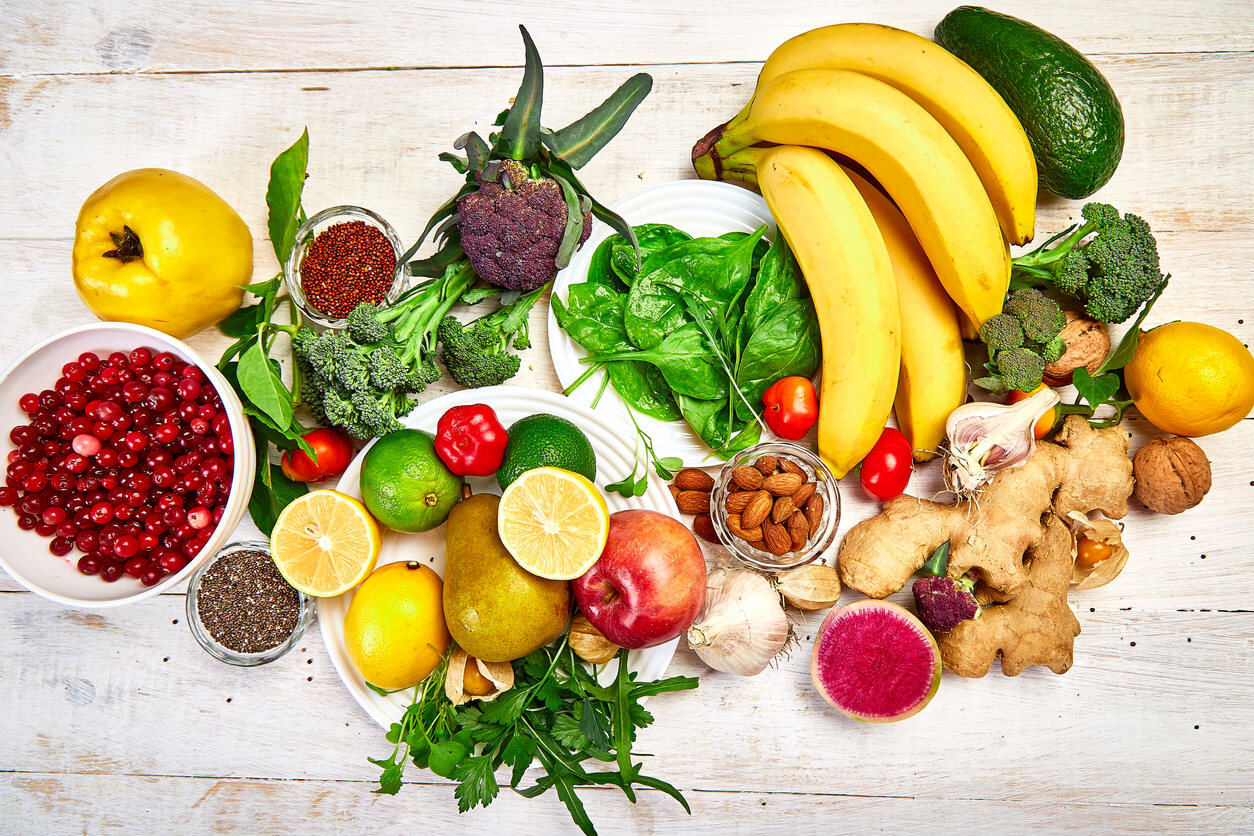Fiber During Pregnancy

Gestation is considered a time of many physical, emotional, and physiological changes in a woman’s life. To make the whirlwind of changes more bearable and avoid health disorders, it’s important to increase the intake of certain key nutrients. For example, fiber during pregnancy helps combat uncomfortable constipation. Keep reading to find out why fiber benefits pregnancy and which foods contain it.
What is fiber?
Fiber is a type of complex carbohydrate that, unlike starch, isn’t digested by our enzymes. It passes intact to the intestine, where it performs important functions. There are different types of fiber, such as soluble (it can be solubilized by water) and insoluble. In addition, some experts also consider resistant starch and some small carbohydrates, such as fructooligosaccharides, as fiber.
What are the benefits of fiber during pregnancy?
According to the journal Food Science and Nutrition, dietary fiber has several benefits for pregnant women:
- It aids in proper digestion during pregnancy.
- It’s a carrier of B vitamins.
- It contributes to optimal weight gain during pregnancy.
- It favors good blood sugar control.
- It helps to prevent gestational hypertensive disorder.
- It nourishes and increases the diversity of the intestinal microbiome.
- It prevents constipation.

Why does constipation occur during pregnancy?
Between 11 and 40% of pregnant women suffer from constipation, which occurs more frequently in the third trimester of gestation. However, the indications to prevent it begin during the first trimester. Constipation is characterized by infrequent bowel movements, hard stools, and difficulty in passing them. It can also be accompanied by abdominal pain.
Progress in Nutrition magazine explains that the causes of gestational constipation are multifactorial. They’re listed below:
- Increased release of progesterone. This hormone, together with relaxin, relaxes the muscles of the body. There’s less contractility of the stomach, esophagus, and colon. Ultimately, the intestines move less and digestion slows down.
- Increased absorption of water and sodium in the colon between weeks 12 and 20 of pregnancy. Stools become harder and, as a result, constipation occurs.
- Motilin, a hormone that stimulates movement through the digestive tract, is inhibited.
- The pressure exerted by the uterus on the bowel increases as the baby grows and further reduces bowel movement.
- Decreased maternal physical activity.
- The common use of iron supplements in the pregnant population results in constipation.
How does fiber during pregnancy prevent constipation?
There’s no doubt that fiber is a natural laxative and prevents constipation. The addition of 20 to 35 grams of fiber per day has been found to increase the incidence of defecation. Of course, the mechanism will also depend on whether it’s soluble or insoluble fiber.
- Soluble fiber: Acts like a gel, as it causes a greater amount of water to remain in the stool, which makes it softer and increases its volume. This makes stools easier to pass.
- Insoluble fiber: Promotes the movement of stool through the digestive tract. In addition, while it accelerates the passage of feces through the intestine, these increase in size and prevent the feeling of constipation.
Other functions of fiber
Resistant starch and fructooligosaccharides act as a type of soluble fiber. They also help regulate blood sugar and lipids, serve as food for bacteria in the gut, and enhance the protective effect of the intestinal barrier.

What are the sources of fiber?
The NIH explains that foods that are sources of soluble fiber are oats, beans, lentils and other legumes, barley, apples, blueberries, nuts, citrus fruits, quinoa, and amaranth, among others. These contain beta-glucan and mucilages that are water binders and act as thickeners. Pectin is also part of this group and is found in apples, pears, guava, citrus fruits, and green fruits.
Insoluble fiber is found in wheat bran, whole grains and cereals, nuts, vegetables, leafy greens and cabbage, broccoli, cauliflower, celery, and the skin and pulp of fruits.
How much fiber should the pregnant woman consume?
The general recommendations for fiber during pregnancy, according to the Institute of Medicine of the National Academy of Sciences, oscillates between 25 and 30 grams per day. In addition, this should be accompanied by sufficient water.
Establish an adequate diet with a nutritionist
Fiber during pregnancy should be distributed among the 5 or 6 daily meals. In addition, the consumption of the different types should be balanced, according to the disorder to be prevented or treated. Therefore, it’s best to consume about 5 daily portions of vegetables and fruits in their raw form, but properly sanitized, and others that are cooked for their softening. Juices shouldn’t be strained.
It’s also important to increase the consumption of wheat bran and whole grains. Oats, barley, quinoa, amaranth, and citrus fruits provide sufficient soluble fiber. The diet plan should be guided by a nutrition professional for safe and reliable results.
Gestation is considered a time of many physical, emotional, and physiological changes in a woman’s life. To make the whirlwind of changes more bearable and avoid health disorders, it’s important to increase the intake of certain key nutrients. For example, fiber during pregnancy helps combat uncomfortable constipation. Keep reading to find out why fiber benefits pregnancy and which foods contain it.
What is fiber?
Fiber is a type of complex carbohydrate that, unlike starch, isn’t digested by our enzymes. It passes intact to the intestine, where it performs important functions. There are different types of fiber, such as soluble (it can be solubilized by water) and insoluble. In addition, some experts also consider resistant starch and some small carbohydrates, such as fructooligosaccharides, as fiber.
What are the benefits of fiber during pregnancy?
According to the journal Food Science and Nutrition, dietary fiber has several benefits for pregnant women:
- It aids in proper digestion during pregnancy.
- It’s a carrier of B vitamins.
- It contributes to optimal weight gain during pregnancy.
- It favors good blood sugar control.
- It helps to prevent gestational hypertensive disorder.
- It nourishes and increases the diversity of the intestinal microbiome.
- It prevents constipation.

Why does constipation occur during pregnancy?
Between 11 and 40% of pregnant women suffer from constipation, which occurs more frequently in the third trimester of gestation. However, the indications to prevent it begin during the first trimester. Constipation is characterized by infrequent bowel movements, hard stools, and difficulty in passing them. It can also be accompanied by abdominal pain.
Progress in Nutrition magazine explains that the causes of gestational constipation are multifactorial. They’re listed below:
- Increased release of progesterone. This hormone, together with relaxin, relaxes the muscles of the body. There’s less contractility of the stomach, esophagus, and colon. Ultimately, the intestines move less and digestion slows down.
- Increased absorption of water and sodium in the colon between weeks 12 and 20 of pregnancy. Stools become harder and, as a result, constipation occurs.
- Motilin, a hormone that stimulates movement through the digestive tract, is inhibited.
- The pressure exerted by the uterus on the bowel increases as the baby grows and further reduces bowel movement.
- Decreased maternal physical activity.
- The common use of iron supplements in the pregnant population results in constipation.
How does fiber during pregnancy prevent constipation?
There’s no doubt that fiber is a natural laxative and prevents constipation. The addition of 20 to 35 grams of fiber per day has been found to increase the incidence of defecation. Of course, the mechanism will also depend on whether it’s soluble or insoluble fiber.
- Soluble fiber: Acts like a gel, as it causes a greater amount of water to remain in the stool, which makes it softer and increases its volume. This makes stools easier to pass.
- Insoluble fiber: Promotes the movement of stool through the digestive tract. In addition, while it accelerates the passage of feces through the intestine, these increase in size and prevent the feeling of constipation.
Other functions of fiber
Resistant starch and fructooligosaccharides act as a type of soluble fiber. They also help regulate blood sugar and lipids, serve as food for bacteria in the gut, and enhance the protective effect of the intestinal barrier.

What are the sources of fiber?
The NIH explains that foods that are sources of soluble fiber are oats, beans, lentils and other legumes, barley, apples, blueberries, nuts, citrus fruits, quinoa, and amaranth, among others. These contain beta-glucan and mucilages that are water binders and act as thickeners. Pectin is also part of this group and is found in apples, pears, guava, citrus fruits, and green fruits.
Insoluble fiber is found in wheat bran, whole grains and cereals, nuts, vegetables, leafy greens and cabbage, broccoli, cauliflower, celery, and the skin and pulp of fruits.
How much fiber should the pregnant woman consume?
The general recommendations for fiber during pregnancy, according to the Institute of Medicine of the National Academy of Sciences, oscillates between 25 and 30 grams per day. In addition, this should be accompanied by sufficient water.
Establish an adequate diet with a nutritionist
Fiber during pregnancy should be distributed among the 5 or 6 daily meals. In addition, the consumption of the different types should be balanced, according to the disorder to be prevented or treated. Therefore, it’s best to consume about 5 daily portions of vegetables and fruits in their raw form, but properly sanitized, and others that are cooked for their softening. Juices shouldn’t be strained.
It’s also important to increase the consumption of wheat bran and whole grains. Oats, barley, quinoa, amaranth, and citrus fruits provide sufficient soluble fiber. The diet plan should be guided by a nutrition professional for safe and reliable results.
All cited sources were thoroughly reviewed by our team to ensure their quality, reliability, currency, and validity. The bibliography of this article was considered reliable and of academic or scientific accuracy.
- Sana Zahoor, Masroor Ellahi Babar, Muhammad Mohsin Javed, Tanveer Hussain. Constipation in pregnancy: causes and remedies. Progress in Nutrition 2018; Vol. 20, Supplement 1: 305-311 DOI: 10.23751/pn.v20i1-S.5788.
- Fuller S., Tapsell L., Beck EL Creación de una base de datos de categorías de fibra para cuantificar diferentes fibras dietéticas. J. Alimentos Compos. Anal. 2018; 71 :36–43. doi: 10.1016/j.jfca.2018.05.004.
- Biblioteca Nacional de Medicina de NIH. Fibra soluble vs insoluble. MedlinePlus.gov. Julio de 2020. Consultado el 22 de marzo de 2022. https://medlineplus.gov/ency/article/002136.htm
- Trumbo P, Schlicker S, Yates AA, Poos M; Food and Nutrition Board of the Institute of Medicine, The National Academies. Dietary reference intakes for energy, carbohydrate, fiber, fat, fatty acids, cholesterol, protein and amino acids. J Am Diet Assoc. 2002 Nov;102(11):1621-30. doi: 10.1016/s0002-8223(02)90346-9. Erratum in: J Am Diet Assoc. 2003 May;103(5):563. PMID: 12449285.
This text is provided for informational purposes only and does not replace consultation with a professional. If in doubt, consult your specialist.








